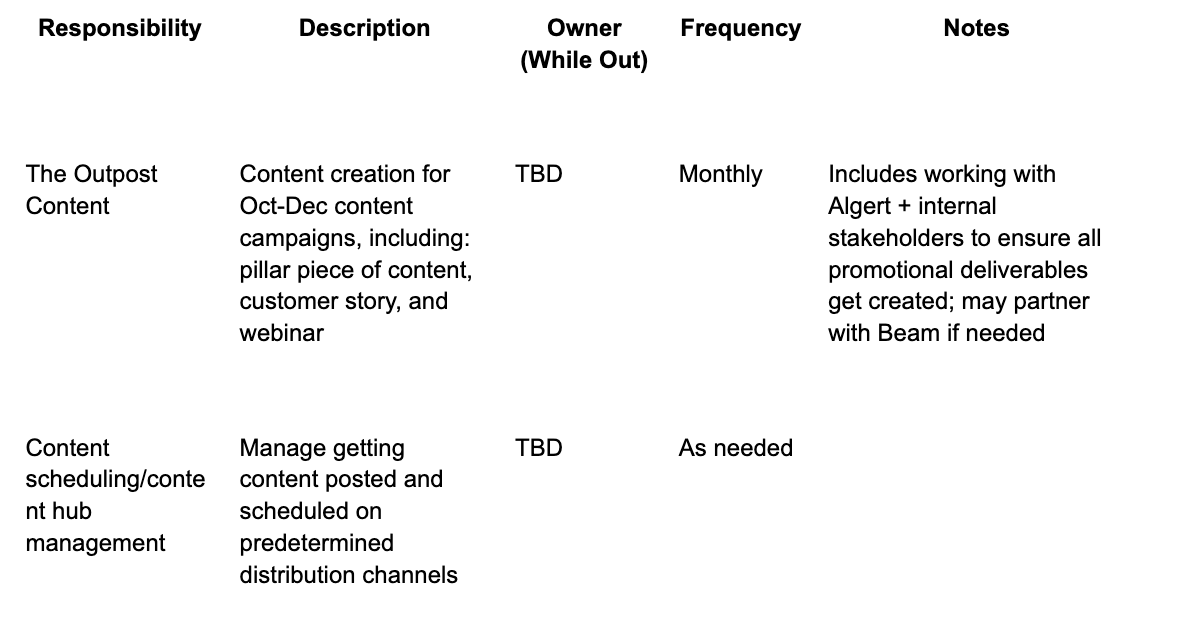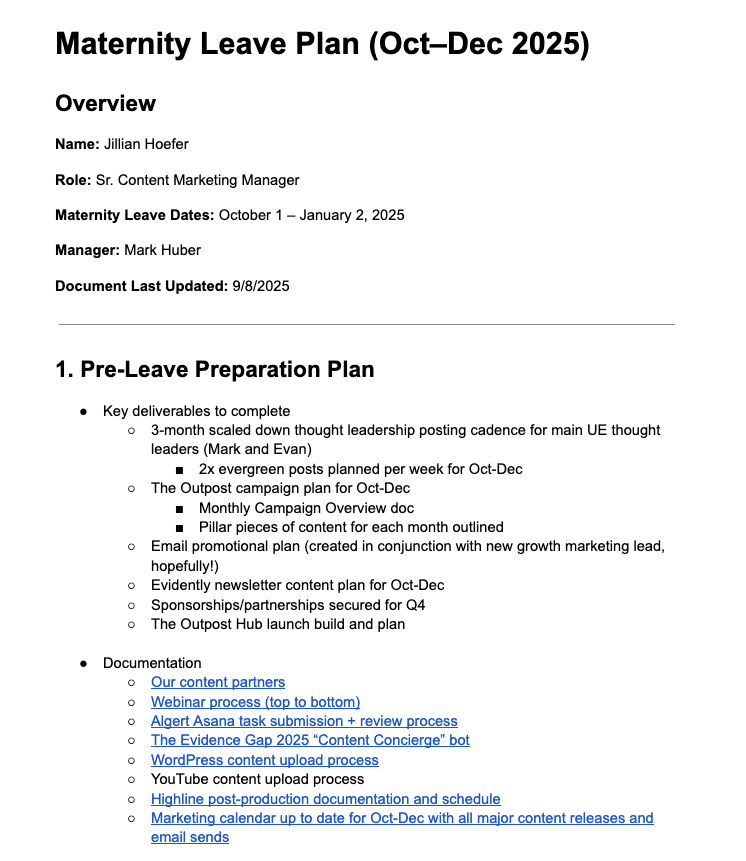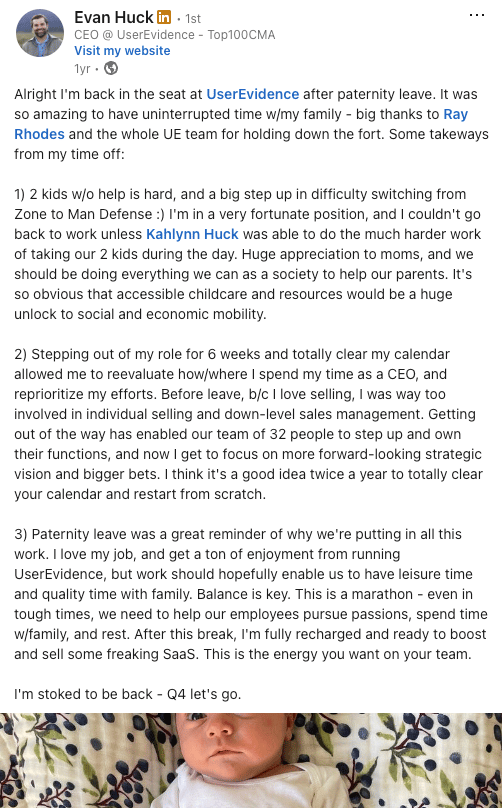- Evidently
- Posts
- What this season is teaching me about leadership
What this season is teaching me about leadership
How I’m learning to lead through someone else’s parental leave
Welcome to Evidently—the bi-weekly newsletter where I share my biggest hits (and get honest about my misses) as a first-time VP of Marketing. If this was forwarded to you, join the 4,000+ people who apparently enjoy watching me figure this job out in real time by subscribing here.
“Hey, I can’t ski anymore. Also, I might throw up.”
That’s how I found out my Senior Content Marketing Manager, Jillian Hoefer, was pregnant.
Last February, we were gearing up to film The Long Game in Jackson, WY. She’d planned to ride down the mountain with us until her body said otherwise.
Looking back, it’s funny that I was one of the first to know.
Also funny that 11 years into managing teams, this is the first time I’ve had to plan for someone’s maternity leave.
I told her right away: “I’ve never done this before. It’ll be a learning experience for both of us.”
From that point forward, we agreed to figure it out together—candidly, without pretending to have all the answers.
Start early. Really early.
After Jackson, things stayed mostly status quo. Jillian would Slack me if she needed an afternoon to rest and I’d cover for her if something came up.
We started prepping logistics three months before her due date—an entire quarter ahead. Pregnancy is unpredictable, and we both wanted to remove as much mental load as possible as the date got closer.
She started documenting everything: what needed to happen to keep things running and what could take a backseat.
Her Maternity Leave Plan doc became our safety net.

Some of the key responsibilities from Jillian’s coverage plan.
Document like your future self will thank you
Now, when I say Jillian documented everything, I’m not joking. I’ve never seen anyone put the level of detail into documentation like she did.

Jillian’s Maternity Leave Plan had its own section just for documentation.
Every process, project, cadence, and contingency plan was detailed out.
In the final weeks, she even kept a running PULL IN CASE OF BABY doc—updated daily with the status of whatever she was working on.

That level of transparency gave both of us peace of mind. I wasn’t lying awake at night stressing over the little things. We had a playbook.
Backfill with some overlap
Finding the right person to temporarily backfill Jillian’s role was obviously important. Just as important: an overlap month for training.
Jillian started interviewing potential options before Highline. She kept me in the loop on how she was feeling about different candidates. I wanted Jillian to make the call and feel comfortable with who’d be filling in for her.
I ended up meeting with her top pick and we both agreed to move forward on the contract.
We brought on Justina Perro, a fractional marketing leader. About a month before Jillian’s leave, Justina worked hourly—shadowing, meeting other members of the team, asking questions, getting context. That overlap made the transition feel less like “Jillian’s gone” and more like “the work continues.”
We set clear boundaries and handed off ownership directly to Justina and our freelancers.
The goal isn’t to replace Jillian. It’s to keep the lights on while she’s out.
I’m still running point on a lot while she’s on maternity leave, but trying not to become the bottleneck holding things up.
Honestly, I don’t know if this is the perfect way to do it—but it’s working so far.
Lead from a place of empathy, not control
There’s no “right way” to lead through this, especially when it’s your first time.
It’s stressful but doable. At the end of the day, we’re slinging software, not saving lives.
The best thing you can do is not try to control everything. Some things will slip. You’ll make judgment calls you’ll rethink later. That’s okay.
What matters is creating a culture of trust—where someone can say, ‘I need to rest,’ without guilt, and a manager can say, ‘I don’t have this all figured out,’ without fear.
That’s what Jillian and I built. And it helped that empathy was already modeled from the top down.
When Evan went on paternity leave last year, he didn’t just talk about “balance.” He lived it—cleared his calendar, handed off ownership, came back sharper.

This kind of leadership gives everyone else permission to slow down when they need to, and to support others when they need to do the same.
I’m trying to model that now. By trusting Justina to work directly with the rest of the team, instead of making her go through me for every decision. It’s not easy to let go, but that’s part of the job.
Still learning
Here’s the truth: there’s never a perfect time for any of this.
We’re coming off Highline, still riding the wave from the Zealot acquisition, and in the middle of The Evidence Gap launch. There’s pressure to finish Q3 strong and have a massive Q4.
Meanwhile, Jillian’s out for the next three months, I’m getting married in November, we’re onboarding a new team member, running interviews for another open role, and trying to keep up with the momentum that’s been building all year.
It’s a lot. And that’s exactly why this lesson matters right now.
Leadership isn’t about keeping it all perfectly in balance. It’s about being honest when you can’t. It’s about trusting people to take the wheel when you need to step back, and giving them the space to learn and grow while they do.
I’m still figuring that out in real time. Some days I handle it well. Other days, not so much. But I’m proud of how we’ve prepared, and even more prouder of the culture that makes it possible to juggle all of this without burning out the team.
When Jillian comes back in January, we’ll pick things up right where we left off. Until then, the lights are on, the work’s moving forward, and the team’s stepping up.
It’s not perfect, but it’s working. And that’s all you can really ask for.
Stuff I’m digging this week
How to turn ChatGPT into your best pipeline source—Kyle Poyar, as usual, making me feel smarter and behind at the same time. AI discovery, AEO, AI SEO… pick your acronym. I’m still figuring out what it actually means for GTM, but this one’s a solid start.
Webinar next week: Closing the Evidence Gap—We just wrapped year two of our Evidence Gap research: 83% of buyers say buying got easier this year, but 67% still walked away because they didn’t trust the proof. Evan Huck and I are breaking it down next week—what’s changed, what’s broken, and how top GTM teams are fixing it.
The New Berlin Public Library “Trust Fall” video—Never thought I’d promote a library’s Instagram post, but it’s too good. Simple, funny, and way too relevant for a company built around trust. Because let’s be real—you can’t trust everybody.
Hold up—what does UserEvidence do again?
Most GTM teams spend millions on outbound, ads, and automation, but freeze the moment a buyer asks, “Do you have successful customers like us?”
Scattered quotes. Outdated decks. Burned-out references.
That’s the moment trust breaks and deals die.
UserEvidence fixes that.
We help your team turn happy customers into your strongest proof. So they can find the right story, advocate, or reference—instantly, when it matters most.
Advocates — Activate your best customers without burning them out.
Evidence — Verified, believable stories and results buyers actually trust.
References — Reliable matchmaking that finds the right customer reference for the right deal.
UserEvidence makes customer proof usable by your entire GTM team—every day, on demand, when trust decides the deal.